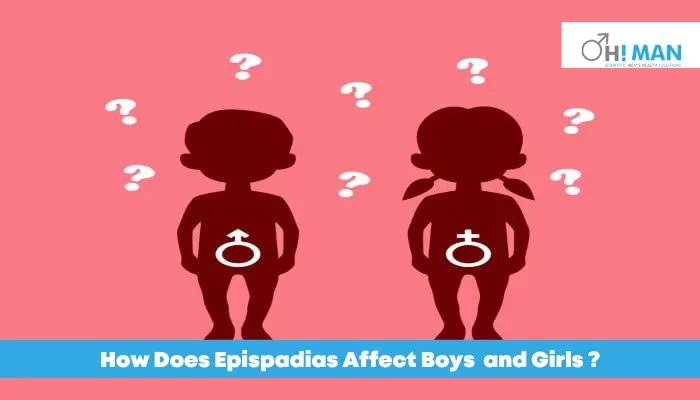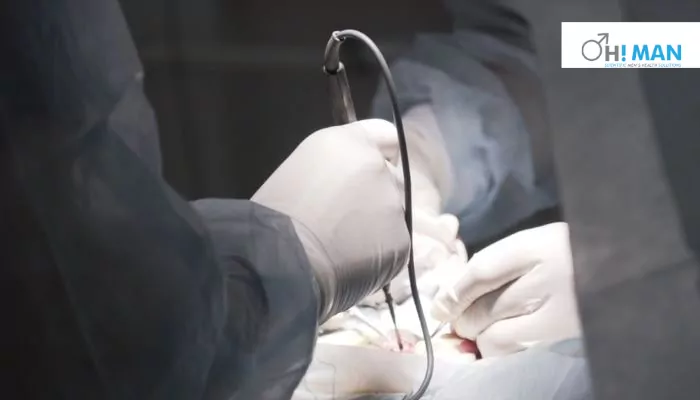Epispadias : Symptoms, Diagnosis & Treatment
Epispadias : Symptoms, Diagnosis & Treatment

Epispadias is an rare congenital (existing at birth) malformation involving the urethral opening (the tube where urine exits from the bladder).
In the case of Epispadias in males, the urethra emerges at the penis top instead of the tip. The area between this hole and the penis tip resembles an open book (gutter).
The urethral mouth is positioned towards the clitoris or abdomen in females with an epispadias. So this leads to abnormal development and function of the external sexual organs and urethra.
The majority of boys and girls are born with normal-looking and functional genitalia. Nevertheless, some infants are born with an epispadias. Further, it may result in a penis or urethra that does not function properly or seems abnormal. Pediatric urologists may perform various surgical procedures to treat this condition.
Table of Content –
How Does Epispadias Affect Boys?
The penis of males with this condition is often broad, short, and curled upward (“dorsal chordee”), and the pelvic bones appear separated widely. Since the penis and these bones are attached, resulting in a penis, the outcome is a penis that is dragged back towards the body.
Specialists categorize Epispadias depending on the precise location of the meatus, and the position of the bladder impacts its ability to hold urine.
The nearer the meatus to the penis’s base, the greater the likelihood that the condition will compromise the bladder sphincter and urine flow. The types of Epispadias in men are:
- Glanular Epispadias: It is located on the penis’s head.
- Penile Epispadias: It is located along the penis shaft.
- Penopubic epispadias: It is located on or close to the pubic bone.
The location of the meatus is predictive of the bladder’s capability to hold urine. The bladder sphincter is probably compromised if the meatus is near the penis base (and the abdomen), and urine will leak.
In most penopubic Epispadias, the pelvic bones do not join at the front. The bladder sphincter does not seal entirely since it is more horseshoe-shaped than ring-shaped. As a result, urine spills out. Most boys with penopubic Epispadias and almost two-thirds of boys with penile epispadias discharge urine under stress. (Examples include coughing and exertion)
Surgical correction of the bladder neck is necessary for the majority of patients.
Well, almost every child with glanular Epispadias has a healthy bladder neck. Further, they can retain their urine and use the toilet properly. Nevertheless, the penis’s aberrant bend and irregular opening will need surgical correction.

How Does Epispadias Impact Girls?
The condition is far less common in females.
Affected girls exhibit pubic bones separated to varying degrees.
This prevents the clitoris from joining in the center, leading to two clitoris halves. Usually, there is also damages to the bladder neck. Under stress, girls with Epispadias frequently leak urine.
(Examples include coughing and exertion) In the majority of instances, early surgical intervention may resolve these issues.
What Happens Under Normal Condition?
The urinary system is comparable to a plumbing system, and it features dedicated “pipes” through which waste may flow.
The urinary system comprises two kidneys, the bladder, two ureters, and the urethra.
The kidneys function as a blood filtration mechanism, and they eliminate contaminants while retaining beneficial proteins, sugars, minerals, and salts. Urine is the excrement produced in the kidneys and passes via two ureters about 10 to 12 inches in length. Further, the ureters are approximately a quarter-inch broad and contain muscular walls. Further, they force urine into the bladder.
The bladder may expand to collect urine till one would empty. Further, it also prevents urine from flowing back into the kidneys.
The urethra is the tube that transports urine from the bladder out of the body.
The male urethra is lengthy. Beginning with the bladder, it passes via the prostate gland, perineum (the area between both the scrotum and the anus), and penis.
However, the urethra is significantly shorter in females, and it extends from the bladder anterior to the vagina and exits the body. Your urethra contains sphincter muscles.
The sphincter complex, commonly known as the bladder neck, is a muscular ring that encircles the urethra. Additionally, they aid in keeping the urethra tight, so urine does not seep out prematurely.
These sphincters start opening as the bladder spasms so that you may expel urine.
Epispadias Symptoms
The condition’s diagnosis takes place during one of the initial newborn checkups while the infant is still in the doctor’s office.
Typically, a diagnosis takes place before anybody ever sees symptoms.
If the condition is relatively minor, medical personnel may not see it.
Parents may not detect anything unless they see urine despite giving toilet training. Further, girls are more likely to go undiagnosed.
Some other epispadias signs and symptoms
Epispadias Causes
This condition is an abnormality in the formation of the urinary system at a particular time of pregnancy. Further, it is sometimes difficult or impossible to determine why the baby did not generally grow over those specific days. In most instances, neither the woman nor the pregnancy presented any visible issues.
Difference Between Epispadias and Hypospadias
Epispadias and hypospadias are urethra-related congenital abnormalities. Both terms are used to define the location of the urethral opening. Epi- refers to above, whereas hypo- refers to below.
Hypospadias affects mostly males. During hypospadias, the urethra does not reach the tip of the penis, and the urethra opening is positioned differently at the base of the penis.
In Epispadias, the tube does not develop normally. Also, the entrance is at the apex of the penis, and the condition is more prevalent in males, although girls may experience this condition.

Diagnosis
Typically, such a condition is diagnosed shortly after birth, and doctors see a boy’s strangely shaped penises or a girl’s clitoris and labia. Further, the physician will send you to a pediatric urologist for epispadias treatment if they identify the condition.
Epispadias Treatment
The primary objective of epispadias treatment is to restore normal appearance and function to the genitalia and is possible with the fewest amount of surgical procedures possible.
Different surgical procedures are accessible for males and girls.
Options for Surgery for Boys
The primary objectives of treatment of this condition in males are to:
- Ensure the penis functions
- Fix penis deformations (dorsal bend and chordee)
- Lengthen the penis enough
- Make the penis seem normal
If the condition affects the bladder, neck, and bladder, the infant will require surgery to ensure continence.
Additionally, surgery may be necessary to maintain fertility.
There are two common surgical procedures, and both offer a penis that appears and functions normally. Further, the operation frequently takes place on infants.
The choice of type relies on:
- Species of epispadias
- Surgeon experience
- Surgeon preferences
Males with the exstrophy-epispadias complex are occasionally born with an undeveloped penis. In such circumstances, surgical procedures demand more expertise and experience.
Modified Cantwell Technique
This technique aims to rebuild the penis. To reposition the urethra to a more natural position, a portion of the penis is removed.
The Mitchell Technique
The Mitchell procedure includes disassembling and reassembling the penis. So the doctor might recommend this process to ensure that the urethra is in its most operational and regular position and address the dorsal bend (chordee).
Surgical Options for Women
Reconstruction in females is more straightforward than in males.
The urethra and vagina might be short and close to the body’s front.
The clitoris may consist of two segments. If detected at birth, the two halves of the clitoris may be joined, and the doctor may place the urethra in its usual position.
Additionally, lack of urine control (Urinary incontinence) would not be an issue if treated early enough.
Risk Factors
Occasionally, a fistula may form between the urethra and the skin following major surgery. However, this is not as prevalent with today’s sophisticated surgical methods. If this occurs, the fistula may mend itself, or your child may require an additional operation.
Epispadias often does not affect a woman’s fertility, and infertility may occur in males with penopubic or exstrophy-epispadias complex.
Males affected with penopubic epispadias or the exstrophy-epispadias combination may be sterile. When sperm travels from the testicles to the urethra following ejaculation in typical young males, the bladder neck closes. Further, during ejaculation, the bladder neck might not even shut fully in certain men with this congenital abnormality.
So this permits the sperm to migrate into the bladder from the urethra (retrograde ejaculation). Hence this may pose difficulties for a couple attempting to conceive. Some of these males may have low-quality sperm. Additionally, bending and a small, stumpy penis might make it difficult to have sexual relations.
Yet surgery may alleviate these issues. So consult your child’s doctor on this matter.
Final Say
Most infants with this condition are healthy and normal.
Aside from issues with the pelvic bones and genitourinary system, most organ systems function normally. Due to this, these children do not need several diagnostic testing. However, if the child has any severe form, they posses great risk for other conditions like vesicoureteral reflux or enlarged uterus.
If any man is concerned about penis enlargement or suffering Peyronie’s condition, then the doctors at Ohman can help you treat your condition. The experts at Ohman can help you address your concerns by offering the best penis enlargement medicines in India if your penis size concerns you. Additionally, the doctors here can also prescribe the right approach on treating Peyronie’s condition and recommend the best penile traction devices to treat your condition. Book your consultation with the Ohman experts.
Frequently Asked Questions
1. Is epispadias dorsal or ventral?
The urethral aperture is on the dorsal portion of the penis in men, while a cleft runs the length of the ventral urethral opening in females, all the way to the bladder neck.
2. What does epispadias look like?
In the case of Epispadias in males, the urethra emerges at the penis top instead of the tip. The area between this hole and the penis tip resembles an open book (gutter).
The urethral mouth is positioned towards the clitoris or abdomen in females with an epispadias. So this leads to abnormal development and function of the external sexual organs and urethra.
3. Is epispadias genetic?
As the causes of epispadias are not completely known, there is no conclusive response to this question.



